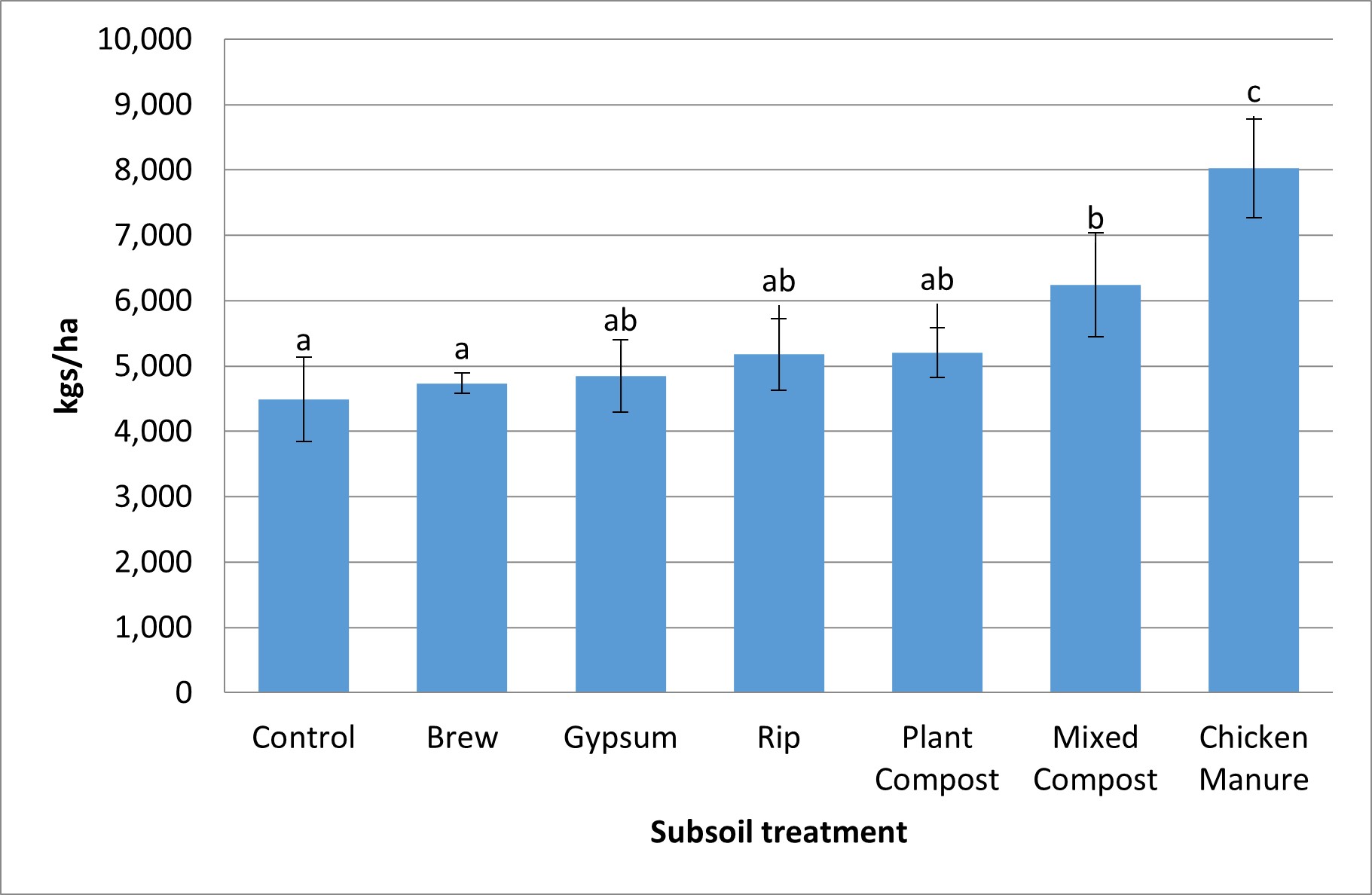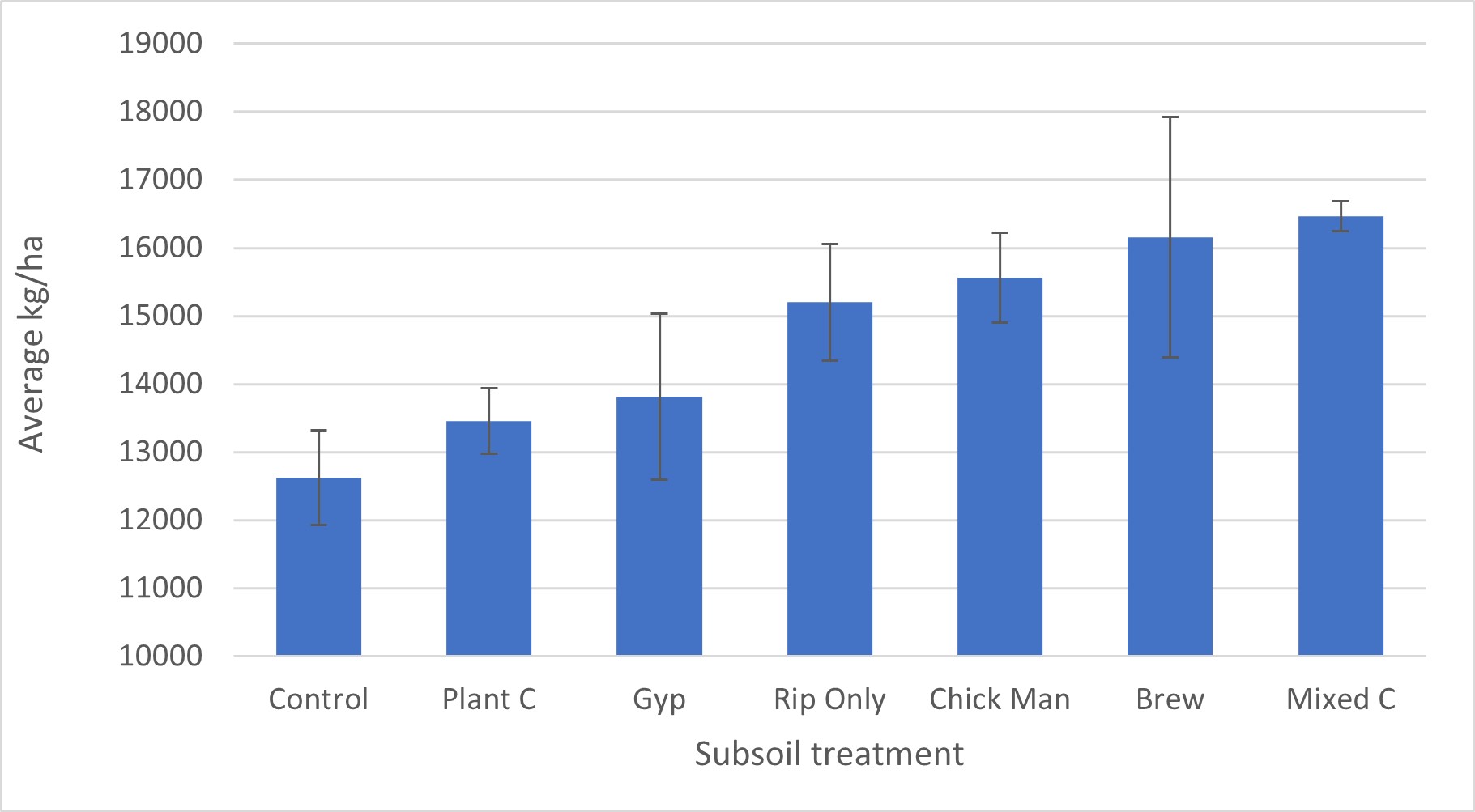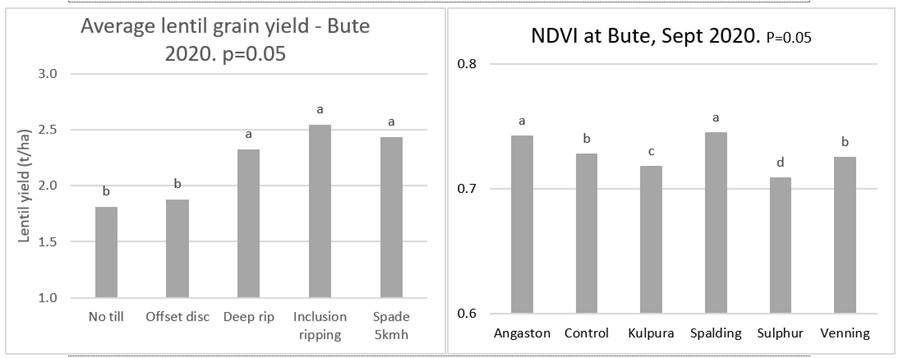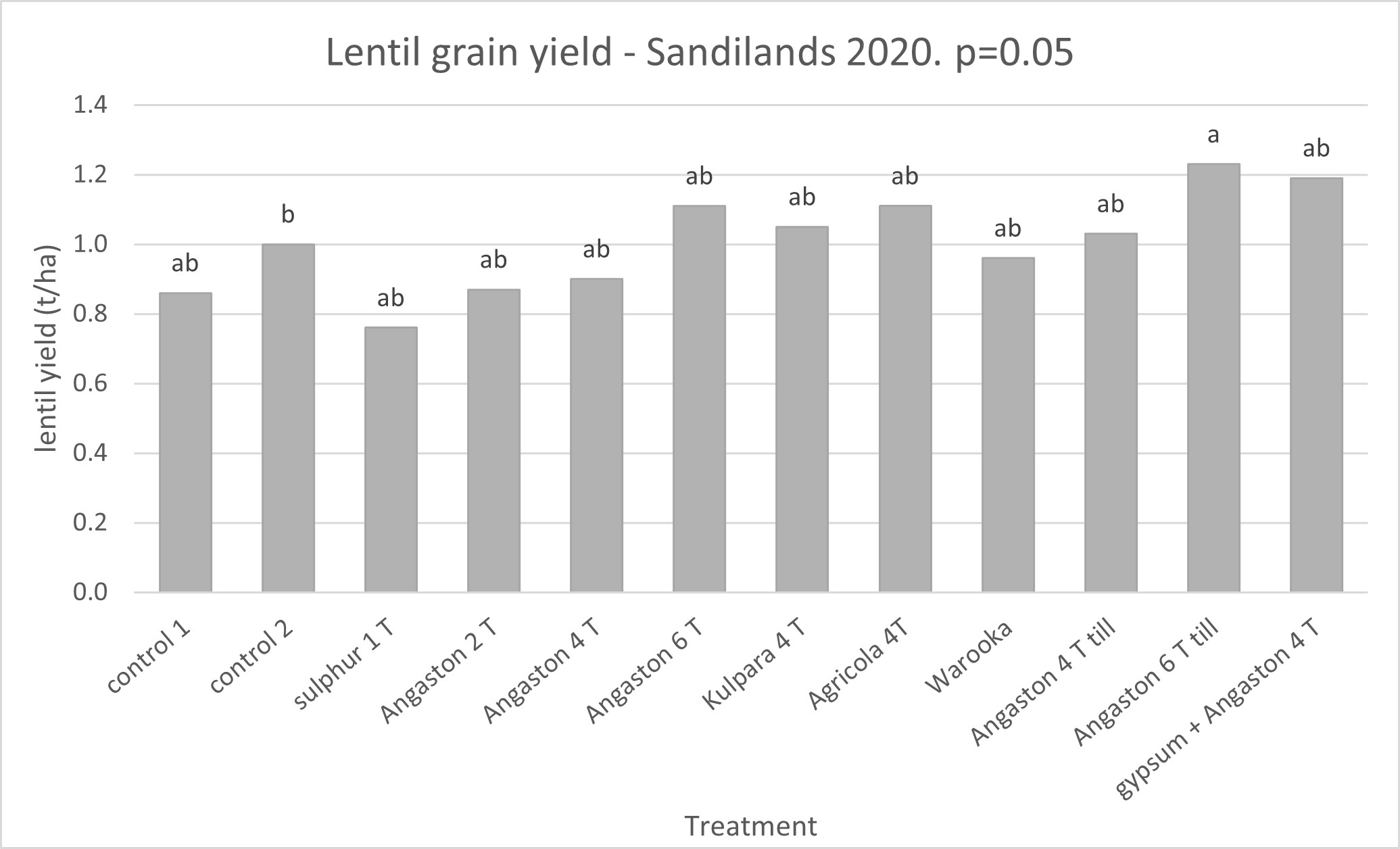The potential to increase the crop productivity by treating hostile subsoils
Author: Brian Hughes (Nuriootpa Research Centre, PIRSA) | Date: 29 Jul 2021
Take home messages
- Subsoil limitations including poorly structured clay, hard pans, chemical toxicities and developing acidity can all restrict root growth and reduce yield potential. Issues can be soil type specific or occur on several soil types. Understanding where and which soils have these limitations is important for developing a treatment plan.
- Several GRDC projects are looking to address these issues and examine treatment options which include soil amendments, improved and tolerant varieties or improved management techniques to identify, manage or reduce the impact.
- The use of subsoil amendments including manures has increased yield by 20-50% over seven years at Stockport on a wet sodic sandy loam over clay, however these techniques have been unsuccessful in lower rainfall areas including the northern Yorke Peninsula (YP).
- Deep ripping has been providing good results on deeper silicious sands and sand over clays, but results have been inconsistent on other soil types. Inclusion plates may add value to deep ripping and provide longer lasting effects.
- Improvement to yield on soils affected by subsoil salinity, high exchangeable sodium percentage (ESP), boron, and high pH is likely to come from improved genetics and tolerance of multiple issues. High aluminium (Al) is another potential toxicity in these layers.
- Careful diagnosis of soil constraints to depth is critical before developing a soil amelioration strategy.
Background
Key subsoil limitations are present in many soils across the South Australian cropping zone and many of these are present across Yorke Peninsula’s variable soils. Inherent issues include poorly structured clays (namely sodic clays), natural high salinity and/ or boron in subsoils, and induced subsoil issues such as hard pans, infertile A2 layers, and subsurface acidity or pH stratification.
Treatment options are diverse and at different stages of research, but include use of various amendments, soil modification techniques and breeding of more tolerant plants better adapted to these conditions, in addition to reducing constraints by modified crop management.
Key soil types on the Yorke Peninsula and observed subsoil issues are shown in Table 1.
Table 1. Key soil types on Yorke Peninsula (YP) and subsoil issues observed
Soil Type | Extent | Key subsurface and subsoil issues |
|---|---|---|
Calcareous loams | widespread | Shallow laminar calcrete on some soils, deeper layers often contain high subsoil salts, high ESP*, high pH and boron |
Deep silicious sand and sand over clay | Bute and Stansbury | Deeper sands often develop hardpans and subsoil infertility, while clay subsoils can be poorly drained, high strength impeding root growth, and high salt, pH and boron. Acidity is an emerging issue including on previously clayed areas in the A horizon. |
Highly calcareous sandy loams and sands | Warooka south | Issues linked to highly calcareous nature and high pH include nutrient tie-up (esp. phosphorus), poor nutrient cycling, and disease. Subsoil salts and boron are occasionally an issue. |
Sandy loams to loams over red and brown clays | Intermittent, mostly north Minlaton | Subsoil issues can be poor drainage through clay layers (sodic or poorly structured), subsoil salts and boron occasionally are an issue, acidity an emerging issue and common in the A horizon. |
* exchangeable sodium percentage.
When examined at a paddock level, many YP paddocks have a range of these soil types which lead to big variations in subsoil limitations, as well as surface pH and nutritional issues.
Method
Subsoil issues are being addressed in several GRDC projects including:
GRDC Subsoil – this includes a series of trials looking at addition of plant and animal products, gypsum and ripping onto sodic/ poorly structured subsoils. Key sites in SA are at Marrabel, Condowie, older sites at Bute and Stockport.
GRDC Sandy soils – includes a series of trials and demonstrations examining different limiting factors of sandy soils. Treatments include effectiveness of ripping, inclusion plates, claying, added organic matter, wetting agents and seeder strategies for repellent sands, etc.
GRDC Acidity – this project is focussing on emerging acidity and correction of sub-surface acidity including stratified profiles. Twelve trials have been established across SA including sites at Sandilands, Bute and Mallala.
GRDC/Soils CRC Calcareous Soils – Has just commenced with trials on highly calcareous soils on the Western Eyre Peninsula and a calcareous loam at Minnipa examining issues including nutrient tie up, poor biological activity and disease issues.
Common subsoil constraints are defined in table 2 below.
Table 2. Definition of subsoil constraints.
Subsoil constraint | Common Depth | Comment/ Test |
|---|---|---|
Sub-surface acidity | 5 to 20cm | pHCa < 5.0 in A horizon, CaCl2 Al > 1-2 mg/kg |
Hardpan/high strength | 10 to 50cm | Weakly compacted sandy layer often with poor root growth in the A2 horizon. Penetration resistance > 2.5kPa |
Sodic clay | 10 to 60cm | Clay B horizon sometimes with columnar or massive structure. These slake and/or disperse when a ped is placed in water. ESP > 6-15 or high other ratios (e.g. CROSS Ratio) |
Toxic layers- salt, boron, high pH. | 40-100cm | Often where fine lime accumulates in the B horizon (Class 1 or 3A Wetherby carbonate class) EC1:5>0.5 or ECe>5 dS/M Boron >15 mg/kg pHw> 9.2 |
High Al on alkaline layers | 40-100cm | High aluminate Al(OH)4- > 0.8mg/l and pHw> 9.0 |
Rubbly broken calcrete | 30-60cm | Wetherby class 3B/ 3C - often root growth is moderate through these layers apart from the rubble |
Laminar impermeable calcrete | 30-100cm | Wetherby class 2- difficult for roots to penetrate apart from cracks and solution pores |
Results and discussion
Multiple subsoil constraints are present and vary with soil types across paddocks. Careful diagnosis of soil constraints to depth is critical before developing a soil amelioration strategy. Methods of detection include chemical and physical testing with precision approaches or soil type variation to understand paddock variability. Yield maps and NDVI measurements can also highlight areas of low or declining soil fertility.
Subsoil amendments
Mixed results have been seen across several subsoil amendment trials over the last seven years. At Stockport on a shallow sandy loam over a red-brown sodic clay which suffers some waterlogging, positive yield and plant dry matter responses have occurred each year since the amendments seven years ago. Chicken manure and mixed composts incorporated into the sodic B horizon at 25-30cm have given the best results, and recent sampling highlighted positive impacts on soil structure up to 15cm away from the where the amendment was originally placed. Dry matter production results for 2019 and 2020 are presented in Figures 1 and 2.

Figure 1. Dry matter of an oaten hay crop 6 years after application in 2019 (Stockport).

Figure 2. Dry matter of canola 7 years after application in 2020 (Stockport).
At the Marrabel site (established in 2018) some responses to surface applications of amendments and subsoil treatments including chicken manure, lucerne hay and wheat straw and nutrients have been recorded, although results have been variable, and returns are yet to be greater than the costs.
However, at the lower rainfall sites at Bute and Hart (on calcareous loams) and Condowie (on shallow sandy loam over sodic clay), no significant responses have been achieved over the last four years with some treatments producing negative impacts.
Deep ripping
Consistent responses to deep ripping have been seen on deeper silicious sands and thick sand over clays, however, results are variable on sandy loams over reddish clay and various calcareous soils. The use of inclusion plates may add value to the ripping by enabling less recompaction and longer benefits.
Work by Dzoma et al. (2020) has demonstrated the benefits of ripping compacted Mallee sands at Buckleboo and Peebinga over 2018-2020. Ripping was undertaken at five depths using two tyne spacings. The most economic result was from ripping to 70cm deep, and the 60cm tyne spacing of was equally effective as 30cm. Other constraints (e.g. water repellency, fertility, acidity) need to be considered whether considering soil amelioration of silicious sand as well as erosion risk.
At the Sandilands trial site on an acid brown loamy sand over reddish clay, un-replicated ripping and lime led to significant increases in wheat yield, while ripping on its own had a much smaller effect (Table 3).
Table 3. Lentil yield response to ripping treatments (Sandilands), mean of two reps only.
Treatment | Mean Yield (t/ha) |
|---|---|
Control | 0.828 |
Ripped to 30cms | 0.856 |
Cultivated only control | 0.890 |
4 T/ha lime + rip to 30cms | 1.187 |
Sandy soil modification
In a trial established by Trengove Consulting at Bute on a sand over clay soil in 2019, deep ripping, ripping plus inclusion plates and spading gave lentil yield increases up to 0.75t/ha in 2020 (see Figure 3a). A lime product comparison trial showed a dry matter production response to Spalding and Angaston lime products, however, this response did not result in a significant yield increase (Figure 3b).

Figure 3. Grain yield of lentil following soil modification (left) and normalised difference vegetation index (NDVI) of lime source trial at Bute 2020 (right).
Overcoming subsoil salt, high pH and boron
Past research has examined genetic variability in the tolerance of crops to subsoil salinity and boron. In recent times screening has included high pH and a form of aluminium present on high pH soils (Schilling 2020). Table 3 below shows tolerant categories established for old commercial wheats to high boron, pH and Al.
Table 4. Commercial wheats and their tolerance to high boron, high pH and high aluminium at high pH*(Schilling 2020).
Tolerance category* | Variety |
|---|---|
Tolerant | Emu Rock, Gladius, Mace, Spitfire, Zen |
Intermediate | Corack, Scout, Tammarin Rock, Ventura, Westonia, Wyalkatchem, Yitpi |
Sensitive | Axe, Cobra, Gregory, Hydra, Janz, Magenta, Trojan |
*Varieties were classified as tolerant if they were tolerant to at least two of the stresses and intermediate for the third; sensitive if they were sensitive to at least two of the stresses and intermediate to the third; and intermediate if they showed intermediate tolerance to at least two of the stresses and were either sensitive or tolerant to the third.
In recent work the program examined over 200 breeding lines and has added sodicity, dispersion and hard pans to the soil constraints examined. Potential improvements in yield of around 10% have been observed where tolerance to multiple constraints was selected.
Acidity on the Yorke Peninsula
Soil acidity is now quite common in the A horizon on non-calcareous soils on the YP. A patchy distribution is often observed, and pH mapping can be used to detect acidic areas in paddocks. Acidity has the potential to spread deeper into the profile particularly where the A horizon is thicker. In 2020 lentil dry matter production and yield (Figure 4) responded to lime applied the previous year were observed at Sandilands on a brown loamy sand over red clay. A combination of high-quality lime at a high rate with cultivation gave the best result, producing a 60% increase in dry matter and a 30% increase in grain yield.

Figure 4. Mean grain yield of lentil at Sandilands in 2020.
Soil pH monitoring early in 2021 showed stratification and sub-surface pH issues even in treatments including tillage. All lime treatments had reduced toxic Aluminium levels in the surface (0-5cm) but issues were still evident deeper in the profile (5-15cm).
Conclusion
Multiple subsoil constraints are present and vary with soil types across paddocks. Careful diagnosis of soil constraints to depth is critical before developing a soil amelioration strategy.
Hard pans and deep ripping responses are common on silicious sands, but are less predictable on other soil types. High soil strength and water repellency on sandy soils can be overcome by using deep rippers, inclusion plates, spaders and delvers. The application of amendments including manures and composts into poorly structured subsoil clays have shown promise at Stockport, but have had limited response in drier areas.
Calcareous loams often have several subsoil toxicities, although calcareous sands are less affected. Toxic levels of boron, salinity and Al, along with high pH and sodicity are being examined across wheat varieties with the aim to provide multiple tolerance to these toxicities.
Sub-surface acidity is becoming more common on soils with deep A horizons, and early detection and treatment with lime will prevent yield declines.
Acknowledgements
The research undertaken as part of this project is made possible by the significant contributions of growers through both trial cooperation and the support of the GRDC, the author would like to thank them for their continued support. Additional support has been provided by PIRSA, DEW, SAGIT and Hills and Fleurieu Landscape Board to some components of the project.
Useful resources
References
Dzoma, B, Wilhelm, N, Drum, H and Zeppel, K (2020) Deep ripping improves crop yields on compacted mallee sands. EP Farming Systems Summary 2020
Schilling, R and McDonald, G (2020) Groundcover articles- Fortified Wheat show promise on sodic soils
Schilling, R and McDonald, G (2019) Groundcover article – Tolerance tested against subsoil constraints
Woodard and Hughes (2020) GRDC Subsoil Sodicity Stockport Trial internal report PIRSA
Contact details
Brian Hughes
Nuriootpa Research Centre
PIRSA Box 245, Nuriootpa SA 5355
0429691468
brian.hughes@sa.gov.au
GRDC Project Code: DAV1606-001RMX, UOA1905-015RTX,
Was this page helpful?
YOUR FEEDBACK
